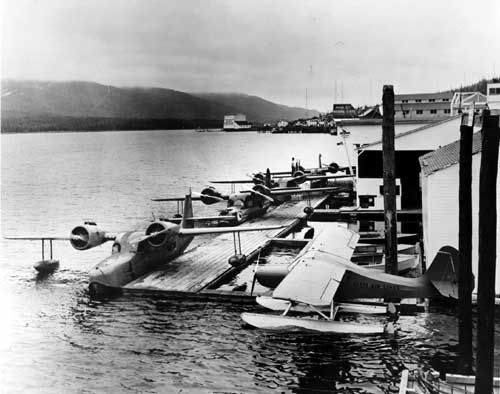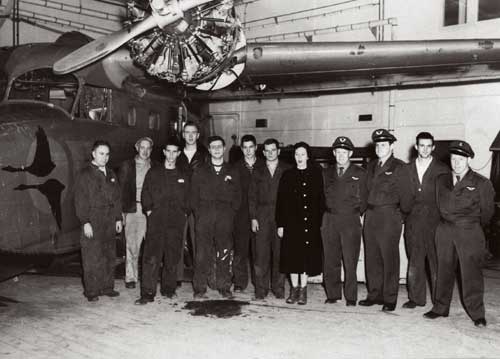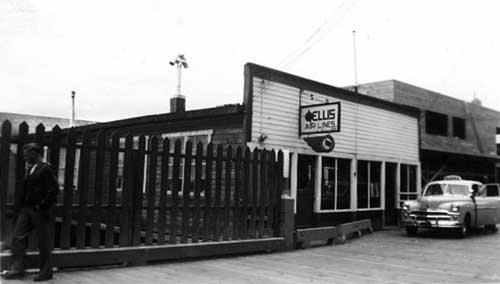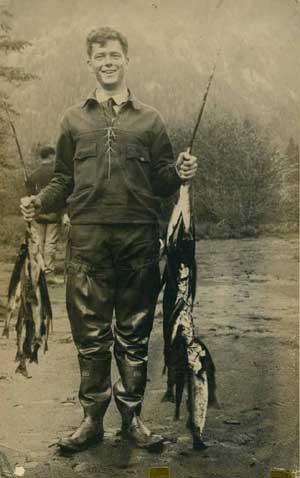 A long, full life 1903-1994 By June Allen June 20, 2003
Back in 1927, when 24-year-old Bob Ellis first soloed as a Naval Reserve pilot at Sand Point Army airfield near Seattle, it was still the era of open cockpits when flyers wore Snoopy-memorialized leather helmet, goggles and wind-whipped white scarves made from parachute silk - no synthetic fabrics then! "Was being a flyer glamorous back in those days?" he was asked in a 1989 telephone interview. "Well, we pilots were somewhat aware of the adulation," he answered with mock modesty. Then he hollered to his wife, "Hey, Peg, was I glamorous back in the early days? Yeah? Uh huh." And then to the interviewer he said, "Peg says she was more interested in when I'd be home for dinner." Ellis's aviation career may have been glamorous only on occasion, but it was always interesting and sometimes exciting! In his years as Ketchikan's premier air carrier, in weather that might be considered "very often marginal," Bob saw all sides and facets of Southeastern Alaska aviation. In his YKS-6 Cabin Waco, he carried to and fro the region's mail, news (and gossip), groceries, prescriptions and sundries, impatient businessmen, expectant mothers, the ill and injured. His usual routes were between Ketchikan and towns on Prince of Wales Island, but he flew almost anywhere his passengers wanted to go. He was once asked to transport a donkey named Dammit to Craig! The donkey - actually a burro - was too big for the plane and had to be shipped by boat. But on the critter's arrival at Craig, Bob Ellis took advantage of all the hoopla during the town of Craig's impromptu donkey-welcoming parade and had ready big painted signs that said "Don't be a jackass, fly with Ellis Air." The burro later became a retiree in Ketchikan, fondly tended by volunteers. While Alaska pilots in the early Depression-era years of the 1930s made good money - $125 a month! plus $5 per hour when they actually flew - that income was earned only in the short periods of summer months. It was an economic challenge to make it stretch to make it through the no-flying winters. Ellis said that every winter Alaska pilots would fly their planes to Seattle, work on the planes, give them new paint jobs and a new names. "When we came back home for the next season, we just let everyone think we had brand new planes," he once confessed. The pilot-hero with the irrepressible sense of humor was also kind and understanding, especially where kids were concerned. Several generations of Ketchikan youth - who later became pilots, aircraft mechanics or just plain fans - trace their interest in aviation back to Bob Ellis and his airplane(s). Children all across the nation in those earliest days of flying machines were fascinated by planes and the idea of flight! They stood on the streets or on the docks and shouted to the low-flying planes, "Gimme a ride! Gimme a ride!" Little boys in the 1930s wore the latest style aviator caps, with or without goggles. In Ketchikan, with its own local hero, boys hung around Ketchikan's seaplane docks and hoped for notice.  Donor: Bob Ellis, THS 74.11.13.7 Photograph courtesy Ketchikan Museums - Tongass Historical Society The late Ralph Bartholomew was one of those smitten with airplanes. Ralph loved to tell the stories of his boyhood in Ketchikan. "I was maybe 11 in the early '30s when I started to skip Sunday School to sneak down to the Tongass Avenue hangar. I'd hang around there in the summertime, too, when it was the Alaska Southern outfit. When Bob Ellis came around, he'd give me little jobs to do, like sweeping, or washing windows. Then later I got to pump out pontoons and maybe pump gas. I just loved that Lockheed Vega and the Fairchild 71! My pay was to go up for rides in those planes! I remember Bob in knickers and long green socks. Those knickers made sense for someone jumping off and on floats. But then another outfit bought the operation he worked for and he had to wear uniforms, with long pants." Styles change. Ketchikan's Gerald "Bud" Bodding, himself an aviation legend in Southeastern with the nickname "Father Goose" in honor of his years and miles in those beloved Grummans, was in high school when he watched Bob Ellis land the Lockheed Vega in Juneau and saw him and his bride Peg climbing out through the overhead hatch. Bob and Peg were married in Seattle in 1930.Bodding remembered one memorable night in Juneau when Ellis had tied up his plane for the night and the next morning came up to the boy and said, "Warm up my airplane for me, would you?" Bodding was thrilled and never forgot that Ellis had enough confidence in him to let him warm up that airplane. Early in 1929, Bob Ellis, then a two-year Navy veteran flier, received his commercial pilot's license, and later that same year went to work briefly for Alaska Washington Airways. He was navigator for pilot Ancel Eckmann when their 1929 flight went into the record books as being the first non-stop flight from Seattle to Juneau! They took off from the Renton, Wash., airport early in the morning and arrived in Juneau seven hours and 35 minutes later. It was the first time a Seattle newspaper was read in Juneau the same day it was read in Seattle! Once in Alaska, Bob decided to get married and move north permanently.  Employees and company plane with the Ellis logo of two flying geese. People pictured are (left to right): Jay Snodderly, Mel Wick, Clark Stump, Jerry Johanson, Bob Newell, Chuck Traylor, Al Tavis, Jody Lorenz (Aegerter), Wes Sande, Roger Elliott, Ed Zaugg, Joe Diamond. KM 98.2.1.5 TEMP Photograph courtesy Ketchikan Museums The early 1930s were the years when pilots around the world were trying for all sorts of record flights. In July of 1933, two separate daredevil pilots, Jimmy Mattern and Wiley Post were each trying for a record solo flight around the world. Mattern, headed for the leg across the Bering Sea to Nome, unfortunately went down in Siberia. Bob Ellis was among the members of the relief expedition sent out on the rescue mission. Ellis was among the fliers in Nome when a Russian pilot and plane flew the rescued Mattern to Nome. And Ellis was among those who flew the famous flyer from Nome to Hazelton B.C. (Mattern was luckier than his rival Wiley Post, who would die along with Will Rogers in a crash near Barrow in 1935.) In later life, Bob Ellis would shake his head when he thought about flying in those early days in Alaska, mentioning that the best "advanced" training for bush flying anywhere in Alaska was sharing gossip with other Alaska pilots! It was flying over some of the most rugged and remote waters and terrain in the world! And yet it was accomplished with few landing fields and without benefit of instruments, mooring floats, weather reports or radio. In fact, he recalled that his first voice-radio wasn't installed until 1937! There were usually charts available when flying over water, but for many inland regions, pilots had to rely on vague descriptions of terrain from others. And there were no manuals - no airplane, engine or flight manuals to tell a pilot how to do it right or what he did wrong. For Southeastern float planes, Ellis once explained, the bad weather techniques in those days was to fly low, very low, sometimes amounting to a mere five feet above the water. Or even with pontoons skipping along the surface of the water when visibility conditions were at their worst! But Bob Ellis weathered all those things. He established his own Ellis Air business in Ketchikan in 1936. For two years he personally trundled package pickups and deliveries in the basket of his bicycle. It wasn't until 1938 that he bought a car. He worked hard, and on Nov. 20, 1939, a small article appeared in the Ketchikan paper that said, "It was an epochal flight for pilot Bob Ellis when he flew from Craig to Ketchikan yesterday afternoon. Pilot Ellis took the ten- thousandth passenger who has flown with him during the ten years he has been flying commercially in Alaska, mostly in Ketchikan."  The terminal was where everyone met everyone else as their baggage was being unloaded. In the cafe and waiting area of the terminal was a long Rie Munoz mural of Ketchikan and Ketchikan travelers. It was painted over after the terminal closed and the building changed hands. Photograph courtesy Ketchikan Museums When war was declared in 1941, pilot Ellis was recalled into active duty, serving first at Sitka and later at Kodiak. In 1944, while still at Kodiak, Ellis - along with everyone else except perhaps the very top brass - was startled to learn that President Franklin D. Roosevelt was to visit the base on his secret wartime voyage to Alaska. It was only the second time in history that a president visited the Territory! (The first had been President Warren G. Harding in 1923, who died just days later, allegedly from Alaska crabmeat poisoning.) Security at Kodiak was tight for Roosevelt, and the crippled chief executive arrived by cruiser and was transferred to a destroyer for the trip to the Kodiak harbor. There he reviewed the troops and attended a luncheon in his honor. Roosevelt had been a prime mover of Alaska's 1935 Matanuska Valley agricultural experiment near Palmer, Alaska, and, at the luncheon, he asked about its progress. Ellis is reported as responding that "the strawberry vines grew so fast in Alaska that they wore out the berries by dragging them across the ground!" To a general's question about how big Alaska's bears are, Ellis is said to have responded, "The tracks weigh about twelve pounds!" The president is said to have enjoyed a good laugh; the account doesn't mention if the general did. At war's end Ellis returned to Ketchikan and resumed management of Ellis Air. Soon after came the era of jet travel. There are those still in Ketchikan who fondly remember landing
In 1962 Bob Ellis retired and bought the yacht Chilton, where he and Peg lived for the next 13 years. In 1976 he and Peg bought and moved to Haywire Island in Refuge Cove. They renamed their tiny islet "Ellis Island," and that name remains to this day. Bob had already in previous years served in various community capacities and so he devoted his retirement to just that, retiring. But then in 1976, Alaska Airlines flight attendants went on strike. The 73-year-old aviation pioneer went to the airport on Gravina Island each day of the strike and hustled bags and boxes as a baggage handler! No pay, just a helping hand for passengers. It was in his blood. In 1989 his health began to fail. He was not happy about it. There were times he didn't recognize his friends on the street or at the grocery store. Death came mercifully sudden one Sunday morning in May of 1994. Bob Ellis was dead at 91. He is missed. But people fondly remember him, their flights in his planes, his pranks and laughter, his community spirit and his love for Ketchikan, and for Alaska.
june@sitnews.org Copyright © 2003 June Allen All rights reserved. Not to be reprinted in any form without the written permission of June Allen.
|
|||||||||





